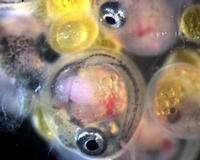Rare Example of Darwinism Seen in Action

A research team of biologists has found experimental evidence that supports a controversial theory of genetic conflict in the reproduction of those animals that support their developing offspring through a placenta.
The conflict has been likened to a “battle of the sexes” or an “arms race” at the molecular level between mothers and fathers. At stake: the fetus’s growth rate and how much that costs the nutrient-supplying mother.
The new research supports the idea of a genetic “arms race” going on between a live-bearing mother and her offspring, assisted by the growth-promoting genes of the father.
The research is described in a new paper, the cover story of the July 24 issue of the Proceedings of the National Academy of Sciences.
Part of the significance of the research is in providing experimental proof of a theory put forth in the 1990s that holds that in animals with a placenta, genetic material from the father and the mother promote different growth rates in the embryo, producing a conflict over nutrients.
The placenta is a complex organ of maternal and fetal tissues that nourishes the developing fetus in the uterus.
Most mammals, excluding marsupials like the kangaroo and the koala, have a placenta. Because of the placenta, a developing embryo remains longer inside the mother (in marsupials, early development of the newborn occurs in the mother’s external pouch).
Evidence to support the conflict over nutrients theory has been found in placental mammals. But the new study is the first to look for this conflict in a species other than mammals that also have evolved placental reproduction.
“We worked with the fish family Poeciliidae and other families in the order Cyprinodontiformes, which included the poeciliids,” said David Reznick, a professor of biology at UCR and a leading authority on live-bearing fishes, who provided all of the life history information for the study.
Reznick explained that most fishes are egg-layers, but some species in the family Poeciliidae have evolved a placenta-like structure and give live birth.
The new research tested the conflict theory by studying samples of the IGF2 growth hormone (insulin-like growth factor 2) collected from 50 species of minnows. The IGF2 gene is found in all vertebrates (including fish and people), and is the primary fetal development growth hormone.
Reznick and the other researchers found that the IGF2 gene sequences had changed in some species of the minnows, showing that segments of the gene had evolved.
“In earlier research, we had found that the placenta had evolved independently several times in these fish,” Reznick said. “In the current research, we found a strong correlation between the evolution of live-bearing and placentation in these fish and the acceleration of the rate of evolution of IGF2 in the fish. This shows that IGF2 plays a vital role in not just mammals, but in fish as well.”
The researchers found that the biggest genetic changes were in those species of the minnows that had developed placentas, supporting the Darwinian theory of natural selection.
The study also provides independent support for the theory of conflict between the male and female genetic material in producing offspring.
In most animals, the male provides his genetic material for the offspring and leaves. The mother has a more intimate relationship with the fetus, nurturing it through her placenta and, in some animals, nursing and caring for the baby after it is born.
But while the father may not be present, the genetic material he provided is hard-wired to provide fast fetal growth, so that his offspring will be the hardiest, best survivors and the ones who demand the most of the mother’s placental nutrients.
The mother, on the other hand, provides genetic material that promotes the same growth level for all of her offspring, so that her nutrients will be available to support her and the offspring from all her matings.
Source: University of California, Riverside















